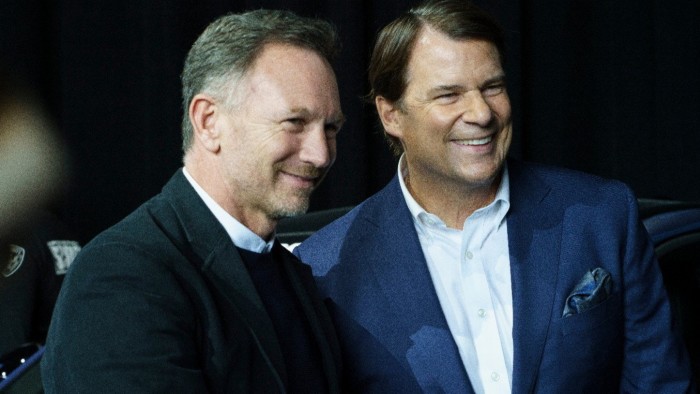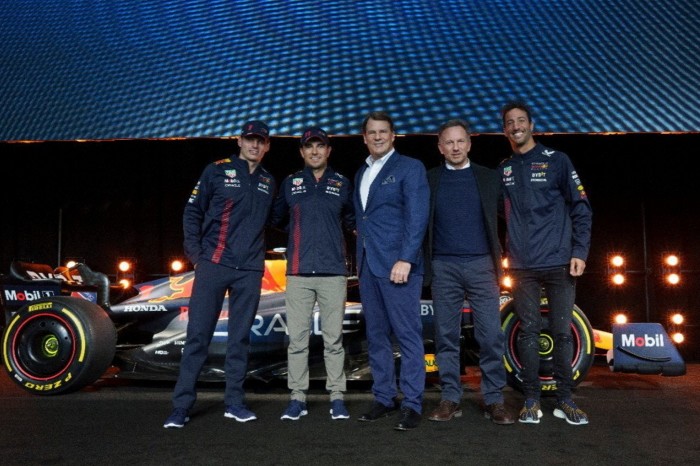Ford’s new focus: how the carmaker buckled up with Red Bull for its return to the grid

Roula Khalaf, Editor of the FT, selects her favourite stories in this weekly newsletter.
In some ways, it was Jim Farley’s choice of hat that did it.
The Ford chief executive had convinced Christian Horner, the head of the Red Bull racing team, to drop into Detroit on the way to the Brazilian Grand Prix. His ambition was to forge a partnership that would allow the US carmaker back into top flight racing.
Yet there was high demand for the world champions, who were searching for a new partner from 2026. Talks with Volkswagen’s Porsche had already lasted for months.
“When Jim walked in, in a [Red Bull driver] Sergio Pérez cap to the first meeting, I felt like it was going to get off to a good start,” recalls Horner. After that, “everything happened very quickly”, he told the FT’s Future of the Car summit earlier this month. “Sometimes, you can tell just from the get go if the feeling is right.”
Since the deal was announced in February, work has begun quickly. On Red Bull’s campus, just outside Milton Keynes, decorators have already replaced the gold and red charging bull emblems outside its engine building with a new, blue moniker: Red Bull Ford Powertrains.
From 2026, Ford and Red Bull will collaborate on power units for F1 cars for both Red Bull teams, including the Scuderia AlphaTauri.
Ford will deal with the battery cell technology and, in return, will get Adrian Newey, Red Bull’s chief technical officer, to help with the aerodynamics on its future vehicles, something that could save the carmaker thousands of dollars on each model. “The battery’s so expensive that aerodynamics turns out to be a primary capability in this new world of electric vehicles,” notes Farley.
Ford was once among the most successful racing teams in the sport, with 10 constructors’ championships and 13 drivers’ titles under its belt when it quit in 2004.
And it already has significant racing programmes with other models, from Mustang track racing to the off-road “King of the Hammers” series in the US and its World Rally Championship team with Puma.
But the brand, under Farley’s leadership, has been eyeing some sort of return to Formula driving for the past two and a half years.
“With a focus on full electric vehicles, we wanted to make sure our racing was aligned to that,” says Mark Rushbrook, head of Ford’s motorsport unit. Yet the options for full electric racing, such as Formula E, were “too limited” in terms of what Ford could learn about batteries and power units, he explains.

However, new F1 rules from 2026 will require half the power for the car to come from a battery within a hybrid system. “Making a bespoke combustion engine under Formula One regulations with fully sustainable fuel” is something that Red Bull can handle, says Horner, “but the cell technology which is going to represent 50 per cent of the power of these cars going forward, is something that we have very little knowledge of”.
These, along with other changes, open the door to Ford, and others, to make real world technological advancements on the racetrack — akin to the development of disc brakes for racing in the 1950s that eventually fed into cars on the road.
“There is as much, or more, opportunity for innovation and technology transfer in F1 than there is in any electric racing series,” says Rushbrook. “There is real technology and innovation as we’re learning about electrics on road vehicles, to test it [on racing cars], try it out, and bring that improved knowledge on to our road cars.”
Unlike other carmakers, such as Audi, Ford has not been driven back to the sport by the growing US audience for the Netflix TV series, Drive to Survive. “We are not entering for brand awareness, we are entering to tell people about the electric products that we can do,” stresses Rushbrook.
The 2026 rule changes have also seen a flurry of other manufacturers re-enter. And Ford’s arch-rival General Motors is looking at wrestling its way back on to the grid. A deal between GM’s Cadillac brand and Andretti Autosport was announced in January, aimed in part at helping the latter with its, so far, unsuccessful bid to join F1 as an 11th team. Rushbrook insists that Ford’s moves were “well in advance” of that by its historic nemesis.
Ford had considered owning a team outright, as it had in the past, but the costs of doing so meant partnering was far more attractive. The collaboration on the projects is not yet clear cut, more like a sausage machine approach, than a traditional division of labour.
While the “high level” shape of the agreement is set out, the teams are coming up with “new projects every day”, says Rushbrook. “We even found some more yesterday”.
So, as race fans look forward to the return of Ford to the track, the partners may explore the potential for collaborations that apply to public roads.
Red Bull’s Newey has long harboured ambitions of making a hypercar for the road, something Ford dabbled in with the GT40, in the 1960s.
The Aston Martin Valkyrie was designed by Newey as part of a Red Bull partnership with the UK sports-car maker. But, in 2020, Red Bull left the partnership and, although Newey has since designed a Red Bull track car, the RB17, it is widely believed he wishes to revisit a road car.
Horner diplomatically calls the Aston Martin episode “a learning experience”.
“It was an interesting insight and one that the advanced technology side of our business learned a huge amount from and I think will stand us in good stead for the future,” he says.
Rushbrook indicates that plans beyond racing may grow into full projects. “It’s still early days of the relationship,” he says. “Every time we talk, we identify new projects to work on, even opportunities beyond that.”
Comments